 Crime
Crime  Crime
Crime  Technology
Technology 10 Hilariously Over-Engineered Solutions to Simple Problems
 Miscellaneous
Miscellaneous 10 Ironic News Stories Straight out of an Alanis Morissette Song
 Politics
Politics 10 Lesser-Known Far-Right Groups of the 21st Century
 History
History Ten Revealing Facts about Daily Domestic Life in the Old West
 Weird Stuff
Weird Stuff 10 Everyday Products Surprisingly Made by Inmates
 Movies and TV
Movies and TV 10 Actors Dragged out of Retirement for One Key Role
 Creepy
Creepy 10 Lesser-Known Shapeshifter Legends from Around the World
 Animals
Animals 10 Amazing Animal Tales from the Ancient World
 Gaming
Gaming 10 Game Characters Everyone Hated Playing
 Crime
Crime 10 Terrifying Serial Killers from Centuries Ago
 Technology
Technology 10 Hilariously Over-Engineered Solutions to Simple Problems
 Miscellaneous
Miscellaneous 10 Ironic News Stories Straight out of an Alanis Morissette Song
Who's Behind Listverse?

Jamie Frater
Head Editor
Jamie founded Listverse due to an insatiable desire to share fascinating, obscure, and bizarre facts. He has been a guest speaker on numerous national radio and television stations and is a five time published author.
More About Us Politics
Politics 10 Lesser-Known Far-Right Groups of the 21st Century
 History
History Ten Revealing Facts about Daily Domestic Life in the Old West
 Weird Stuff
Weird Stuff 10 Everyday Products Surprisingly Made by Inmates
 Movies and TV
Movies and TV 10 Actors Dragged out of Retirement for One Key Role
 Creepy
Creepy 10 Lesser-Known Shapeshifter Legends from Around the World
 Animals
Animals 10 Amazing Animal Tales from the Ancient World
 Gaming
Gaming 10 Game Characters Everyone Hated Playing
10 Fascinating Facts And Stories Involving Body Parts
The body is an accumulated wonder of parts fine-tuned by nature to perform precision tasks. Venture past the usual facts, and things tend to get interesting. In recent times, unknown body parts have turned up in fossils and living creatures, ranging from cute to creepy to deadly.
Doctors have grown things in strange places and traced the bizarre origins of the most normal of features. When life goes wrong, body parts can also unveil gruesome mysteries, suffering buried in history, and medical problems that beggar belief.
10 The Yo-Yo Injury
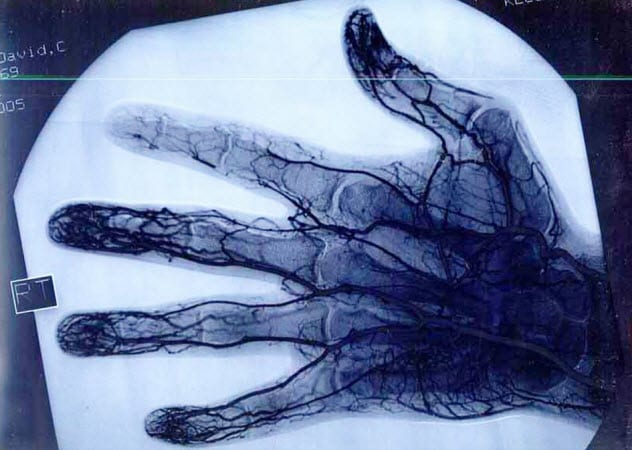
In 2005, Dazzling Dave visited schools in North Dakota. The professional yo-yo performer entertained kids for up to 12 hours at a time. A week later, the man, whose real name was David Schulte, noticed that his right index finger warmed more slowly than the rest. In cold weather, it was also the first to freeze.
When it started shifting colors—alternating between red, purple, and blue—he sought medical help. The doctor suspected a blood clot. A scan showed something else entirely.
There was no blood flow past the second knuckle of the finger. For some reason, the blood vessels had suddenly constricted and for too long. The unusual injury was probably caused by years of hitting that particular finger with a yo-yo.
Technically, it caused a condition known as Raynaud’s syndrome which can result in nerve damage and tissue loss. Luckily, the champion yo-yo artist suffered no lasting problems. A month of popping blood thinners solved the situation.[1]
9 Crankles

In 2017, researchers riffled through the Natural History Museum in London. They found a game-changing fossil. The bones belonged to a carnivore called Teleocrater rhadinus.
When it was discovered in the 1930s, experts failed to find its place in the evolutionary tree. As a result, it was shelved and forgotten. The modern study determined that the creature was 245 million years old. It lived 10 million years before the dinosaurs. Even better, it was one of their ancestors.
Teleocrater‘s main surprise was a body structure more reminiscent of a crocodile than a dinosaur. In particular, they had crankles. Short for crocodile ankles, they gave the animal a reptilian gait on all fours like a monitor lizard.
This was significant. An impossibly long time ago, reptiles called archosaurs split into two lineages: the bird branch (which led to the dinosaurs) while the other remained reptilian, with today’s alligators and crocodiles.[2]
Teleocrater is the earliest-known member from the bird line, but its crankles were like a strange missing link connecting it back to the archosaurs and the reptile branch. This profoundly challenged what scholars thought they knew about early dinosaur evolution.
8 Switchblade Cheeks
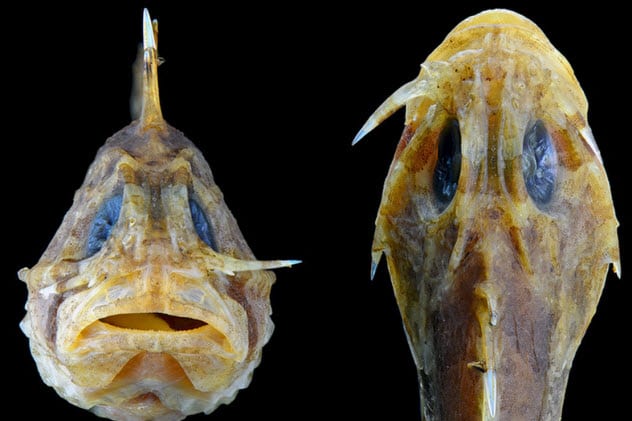
The stonefish is a rare fish. It also haunts Indo-Pacific coastlines as one of the most venomous creatures in the world. In 2003, a pet stonefish died. As the owner was a researcher, the fish hit the dissection table instead of the local pet cemetery. It started 15 years of curiosity about the species.
In 2018, when a “switchblade” was found in its face, the same scientist unraveled the mechanism behind the feature. The whole thing was bizarre. In other fish, the lachrymal bone is solidly fixed underneath the eye as part of the skull. When a stonefish gets huffy, this spike shoots out in a 90-degree angle—on each cheek.
This is no mustache. The lachrymal bones are dangerously serrated. To activate the spines, the fish pulls on chewing muscles in the upper jaw. This rotates and locks the spine through a mechanism shaped like a roly-poly. One stonefish species upped the freaky factor. Centropogon australis fluoresces in two tones. While the head emits red light, the spikes have a green glow.[3]
7 Selam’s Foot
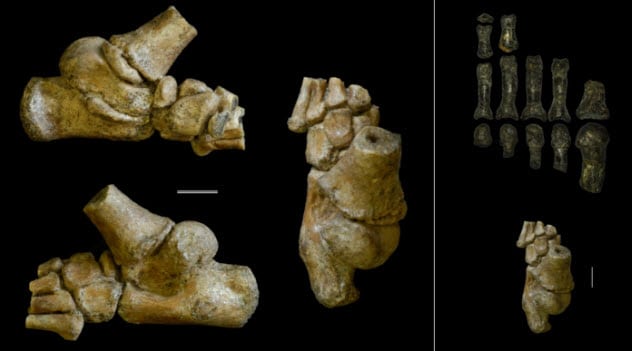
One of mankind’s most famous ancestors is Lucy. Found in 1974, she was an adult Australopithecus afarensis from Ethiopia. In 2000, a second one was found nearby. The female toddler was quickly dubbed “Lucy’s baby.” However, the child was the older fossil, having died around three million years ago, about 100,000 years before Lucy.
The youngster, renamed Selam, had the most complete set of A. afarensis foot bones ever found. Scientists already knew the species walked upright like modern humans. Indeed, Selam’s foot and ankle anatomy was identical to those of people alive today. The unusual part was that the two species developed their feet differently.
While young (Selam died at age three), A. afarensis‘s big toe was more fingerlike. It probably helped them to cling to their parents and trees for safety. Selam’s heel was also more fragile than those of human children.[4]
Even though young A. afarensis were less suited for walking upright, their feet were already designed for life on the ground. Only later would they grow the same strong heel bones present in humans from birth.
6 Scaly Origin Of Teeth
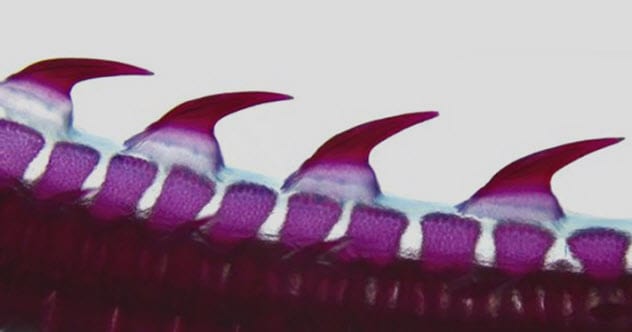
In the quest to find out where human teeth came from, researchers turned to skates. These fish are covered in primitive scales called dermal denticles. Sharks also have them, which is why their skin feels like sandpaper.
A 2017 study found that the scales grew from neural crest cells, a critical element in mammal tooth development. A second find also suggested that teeth evolved from fish skin. Denticles, which roughly resemble teeth, also consist of dentine. A modern tooth is packed with this hard tissue.
However, the discovery does not mean that all species got their snappers this way. Research on zebra fish showed another evolutionary path where scales and teeth evolved from different types of cells. Skate skin presents a strong case that certain species grew scales as armor plating. Somehow, through millions of years, this external skeleton became modified and moved to the mouth as teeth.[5]
5 Hitler’s Death Confirmed
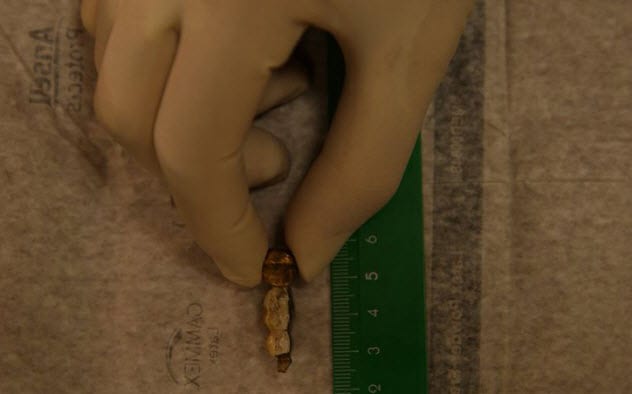
When Adolf Hitler realized in 1945 that he could no longer escape the invading Allied forces, he committed suicide in his bunker. The Russians found his remains and threw the body into a river. For decades, they kept skull fragments to which nobody had access. During that time, rumors abounded that the fuhrer had faked his own death.
The conspiracy theories had sound roots. It is a fact that many high-ranking Nazis escaped when Germany’s power was broken. But things took a weird turn in 2009. Nick Bellantoni, an archaeologist and bone specialist, handled Hitler’s skull at the Russian State Archive.
During a documentary for the History Channel, he declared that the fragments belonged to a woman under 40. The Archive responded by saying that Bellantoni had never been there or handled the remains.[6]
In 2018, the Archive finally permitted French pathologists to study the fragments. The teeth had complex dental work that perfectly matched Hitler’s medical records. Blue stains and a bullet hole showed that the fuhrer’s suicide plan began with swallowing a cyanide capsule, followed by a shot to the head.
4 White Blood

Recently, doctors in Germany faced something they had never seen before. A 39-year-old patient’s blood was so pale and thick that it looked like milk. The medical condition was not a mystery. The nearly comatose patient suffered from extreme hypertriglyceridemia. It is caused by too much fat in the blood.
Siphoning off the offending triglyceride molecules and returning the cleaned plasma to the body usually solves the problem. However, when staff tried the normal route, his viscous blood clogged the hospital’s filtering equipment. Not once, but twice. The problem was a record amount of triglycerides. Around 500 mg/dL is considered “high.” The man’s count read an astonishing 18,000 mg/dL.
Desperate to save his life, doctors resorted to an ancient remedy abandoned by modern medicine—bloodletting. A good amount of the white gunk was drained and replaced with red blood cell concentrates and saline solution. It worked. Although the cause of the severity is unknown, the patient’s genes, obesity, and irregular consumption of his diabetes medication might have combined to cause the mother of all hypertriglyceridemia cases.[7]
3 The Limb Pit
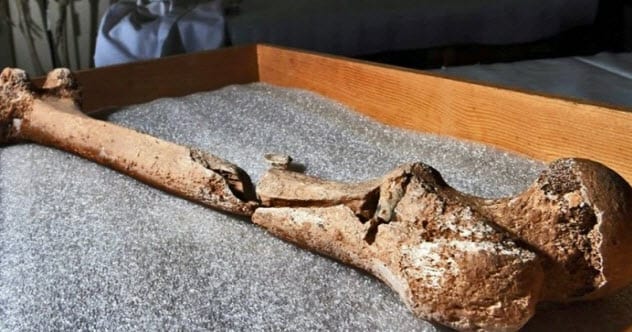
During the Civil War, the Second Battle of Bull Run took place north of Manassas, Virginia, in 1862. In 2018, archaeologists were investigating the battlefield when they discovered something exceptionally rare.
A shallow grave held two soldiers and the sawed-off limbs of up to 11 other men. The complete bodies, Burial 1 and 2, could not be identified other than being Union soldiers from the North.
Both died brutal deaths. Burial 1’s leg had been broken by a bullet which was still stuck in the bone when the skeleton was found. The injury was so bad that field surgeons probably left him to die. This frequently happened when there were too many injured soldiers.
Burial 2 was placed in the pit after the first man and rested slightly on top of him. His own death resulted from three bullets. One smashed his arm, another buried itself in the shin, and a third struck his groin. The bodies, with nine severed arms and legs arranged around them, were a unique find hailed as “one in a million.”[8]
2 The Forearm Ear
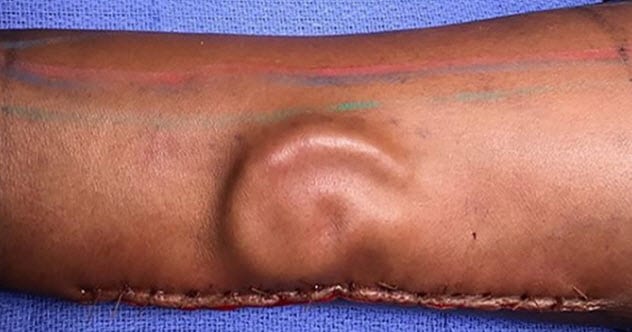
When army private Shamika Burrage returned from leave in 2016, a car accident put her in rehabilitation for months. She also lost an ear. After Burrage recovered, her appearance bothered her so much that a counselor suggested plastic surgery.
In 2018, the William Beaumont Army Medical Center in Texas performed a rare procedure. They took rib cartilage from Burrage and shaped it like an ear. Afterward, it was inserted under the skin of her forearm. For the woman to experience feeling in the ear, doctors needed the new body part to develop fresh arteries, veins, and nerves—all available from the arm.
Once ready, surgeons replaced Burrage’s missing ear. Doctors also took the opportunity to reopen her hearing canal to restore the hearing she had lost. This was the first time that army plastic surgeons had performed this type of operation. However, the procedure dates to the early 20th century. Back in the day, rib cartilage ears were also grown under the skin but without the nerves and blood vessels.[9]
1 Severed Russian Hands

Early in 2018, a fisherman decided to visit a small island near the Amur River in Siberia. Upon arrival, he noticed a hand in the snow. There was no sign of the rest of the body. Soon afterward, the man found a bag stuffed with the same grisly thing. All told, there were 54 human hands severed at the wrist. There was also medical waste nearby.
Social media cried foul after an anonymous sender circulated the photos online, showing the brutal cache in detail. The Russian government was unfazed. Investigators insisted that the amputations had a mundane explanation. Some forensic laboratories in Russia dispose of bodies without identities but keep the hands as a record.[10]
In this case, authorities admitted that the unidentified laboratory broke the law by dumping the hands. Despite lifting fingerprints from only one pair, investigators also kept insisting that the hands were not the result of darker criminal activities.
Read more fascinating facts and stories about body parts on 10 Body Parts That Are Secretly Awesome and 10 Human Body Parts Offered For Sale At Auction.








